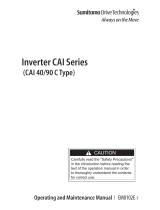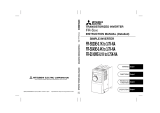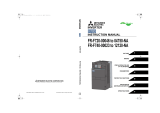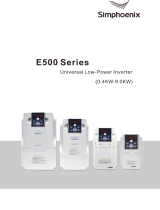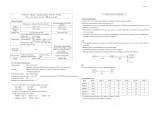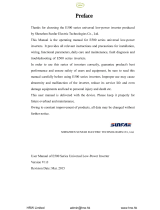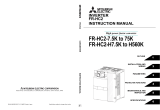Page is loading ...

3
4
5
6
7
1
2
FR-F700PJ
INSTRUCTION MANUAL (Applied)
INVERTER
PRECAUTIONS FOR USE
OF THE INVERTER
PARAMETERS
TROUBLESHOOTING
PRECAUTIONS FOR
MAINTENANCE AND INSPECTION
SPECIFICATIONS
OUTLINE
WIRING
HEAD OFFICE: TOKYO BUILDING 2-7-3, MARUNOUCHI, CHIYODA-KU, TOKYO 100-8310, JAPAN
FR-F720PJ-0.4K to 15K (F)
FR-F740PJ-0.4K to 15K (F)
Air-conditioning inverter
IB(NA)-0600426ENG-B (1303)MEE Printed in Japan Specifications subject to change without notice.
INVERTER FR-F700PJ INSTRUCTION MANUAL (Applied)
B

A-1
Thank you for choosing this Mitsubishi Inverter.
This Instruction Manual (Applied) provides instructions for advanced use of the FR-F700PJ series inverters.
Incorrect handling might cause an unexpected fault. Before using the inverter, always read this Instruction Manual
and the Instruction Manual (Basic) [IB-0600425ENG] packed with the product carefully to use the equipment to its
optimum performance.
1. Electric Shock Prevention
This section is specifically about safety matters
Do not attempt to install, operate, maintain or inspect the
inverter until you have read through the Instruction Manual
and appended documents carefully and can use the
equipment correctly. Do not use this product until you have
a full knowledge of the equipment, safety information and
instructions.
In this Instruction Manual, the safety instruction levels are
classified into "WARNING" and "CAUTION".
Incorrect handling may cause
hazardous conditions, resulting in
death or severe injury.
Incorrect handling may cause
hazardous conditions, resulting in
medium or slight injury, or may cause
only material damage.
The level may even lead to a serious
consequence according to conditions. Both instruction
levels must be followed because these are important to
personal safety.
WARNING
CAUTION
CAUTION
While the inverter power is ON, do not open the front
cover or the wiring cover. Do not run the inverter with the
front cover or the wiring cover removed. Otherwise you
may access the exposed high voltage terminals or the
charging part of the circuitry and get an electric shock.
Even if power is OFF, do not remove the front cover
except for wiring or periodic inspection. You may access
the charged inverter circuits and get an electric shock.
Before wiring or inspection, power must be switched OFF.
To confirm that, LED indication of the operation panel
must be checked. (It must be OFF.) Any person who is
involved in wiring or inspection shall wait for at least 10
minutes after the power supply has been switched OFF
and check that there are no residual voltage using a tester
or the like. The capacitor is charged with high voltage for
some time after power OFF, and it is dangerous.
This inverter must be earthed (grounded). Earthing
(grounding) must conform to the requirements of national
and local safety regulations and electrical code (NEC
section 250, IEC 536 class 1 and other applicable
standards).
A neutral-point earthed (grounded) power supply for 400V
class inverter in compliance with EN standard must be
used.
Any person who is involved in wiring or inspection of this
equipment shall be fully competent to do the work.
The inverter must be installed before wiring. Otherwise
you may get an electric shock or be injured.
Setting dial and key operations must be performed with
dry hands to prevent an electric shock. Otherwise you
may get an electric shock.
Do not subject the cables to scratches, excessive stress,
heavy loads or pinching. Otherwise you may get an
electric shock.
Do not change the cooling fan while power is ON. It is
dangerous to change the cooling fan while power is ON.
Do not touch the printed circuit board or handle the
cables with wet hands. Otherwise you may get an electric
shock.
When measuring the main circuit capacitor capacity, the
DC voltage is applied to the motor for 1s at powering OFF.
Never touch the motor terminal, etc. right after powering
OFF to prevent an electric shock.
IPM motor is a synchronous motor with high-performance
magnets embedded in the rotor. Motor terminals hold high
voltage while the motor is running even after the inverter
power is turned OFF. Before wiring or inspection, the
motor must be confirmed to be stopped. When the motor
is driven by the load in applications such as fan and
blower, a low-voltage manual contactor must be
connected at the inverter's output side, and wiring and
inspection must be performed while the contactor is open.
Otherwise you may get an electric shock.
WARNING

A-2
2. Fire Prevention
3.Injury Prevention
4. Additional Instructions
Also the following points must be noted to prevent an
accidental failure, injury, electric shock, etc.
(1) Transportation and Mounting
(2) Wiring
(3) Trial run
(4) Usage
Inverter (Filterpack) must be installed on a nonflammable
wall without holes (so that nobody touches the inverter
heatsink on the rear side, etc.). Mounting it to or near
flammable material can cause a fire.
If the inverter has become faulty, the inverter power must
be switched OFF. A continuous flow of large current could
cause a fire.
When using a brake resistor, a sequence that will turn OFF
power when a fault signal is output must be configured.
Otherwise the brake resistor may overheat due to damage
of the brake transistor and possibly cause a fire.
Do not connect a resistor directly to the DC terminals P/+
and N/-. Doing so could cause a fire.
Daily and periodic inspections must be performed as
instructed in the Instruction Manual. If the product is used
without receiving any inspection, it may cause a burst,
break, or fire.
The voltage applied to each terminal must be the ones
specified in the Instruction Manual. Otherwise burst,
damage, etc. may occur.
The cables must be connected to the correct terminals.
Otherwise burst, damage, etc. may occur.
Polarity must be correct. Otherwise burst, damage, etc.
may occur.
While power is ON or for some time after power-OFF, do
not touch the inverter (Filterpack) since the inverter will be
extremely hot. Doing so can cause burns.
The product must be transported in correct method that
corresponds to the weight. Failure to do so may lead to injuries.
Do not stack the boxes containing inverters higher than the
number recommended.
The product must be installed to the position where withstands
the weight of the product according to the information in the
Instruction Manual.
Do not install or operate the inverter (Filterpack) if it is damaged
or has parts missing.
When carrying the inverter, do not hold it by the front cover or
setting dial; it may fall off or fail.
Do not stand or rest heavy objects on the product.
The inverter mounting orientation must be correct.
Foreign conductive objects must be prevented from entering
the inverter (Filterpack). That includes screws and metal
fragments or other flammable substance such as oil.
Because the inverter (Filterpack) is a precision instrument, do
not drop or subject it to impact.
The inverter (Filterpack) must be used under the following
environment: Otherwise the inverter may be damaged
.
1 Temperature applicable for a short time, e.g. in transit.
2 When installing the Filterpack of 11K or 15K on the rear
panel of the inverter, do not install on moving objects or
places which vibrates (exceeding 1.96m/s
2
).
CAUTION
CAUTION
CAUTION
Environment
Surrounding
air
temperature
-10°C to +50°C (non-freezing)
Ambient
humidity
90%RH or less (non-condensing)
Storage
temperature
-20°C to +65°C *1
Atmosphere
Indoors (free from corrosive gas, flammable gas,
oil mist, dust and dirt)
Altitude/
vibration
Maximum 1,000m above sea level.
5.9m/s
2
or less at 10 to 55Hz (directions of X, Y, Z
axes) *2
Do not install a power factor correction capacitor or surge
suppressor/capacitor type filter on the inverter output
side. These devices on the inverter output side may be
overheated or burn out.
The connection orientation of the output cables U, V, W to
the motor affects the rotation direction of the motor.
IPM motor terminals (U, V, W) hold high-voltage while the
IPM motor is running even after the power is turned OFF.
Before wiring, the IPM motor must be confirmed to be
stopped. Otherwise you may get an electric shock.
Never connect an IPM motor to the commercial power
supply. Applying the commercial power supply to input
terminals (U,V, W) of an IPM motor will burn the IPM motor.
The IPM motor must be connected with the output
terminals (U, V, W) of the inverter.
Before starting operation, each parameter must be
confirmed and adjusted. A failure to do so may cause
some machines to make unexpected motions.
The IPM motor capacity must be same with the inverter
capacity.
Do not use multiple IPM motors with one inverter.
Any person must stay away from the equipment when the
retry function is set as it will restart suddenly after trip.
Since pressing key may not stop output depending
on the function setting status, separate circuit and switch
that make an emergency stop (power OFF, mechanical
brake operation for emergency stop, etc.) must be
provided.
OFF status of the start signal must be confirmed before
resetting the inverter fault. Resetting inverter alarm with
the start signal ON restarts the motor suddenly.
Do not use an IPM motor in an application where a motor
is driven by its load and runs at a speed higher than the
maximum motor speed.
A dedicated IPM motor must be used under IPM motor
control. Do not use a synchronous motor, induction
motor, or synchronous induction motor under IPM motor
control.
The inverter must be used for three-phase induction
motors or the dedicated IPM motor.
Connection of any other electrical equipment to the
inverter output may damage the equipment.
Do not modify the equipment.
Do not perform parts removal which is not instructed in
this manual. Doing so may lead to fault or damage of the
product.
CAUTION
CAUTION
WARNING

A-3
(5) Emergency stop
(6) Maintenance, inspection and parts replacement
(7) Disposal
The electronic thermal relay function does not guarantee
protection of the motor from overheating. It is
recommended to install both an external thermal and PTC
thermistor for overheat protection.
Do not use a magnetic contactor on the inverter input for
frequent starting/stopping of the inverter. Otherwise, the
life of the inverter decreases.
The effect of electromagnetic interference must be
reduced by using an EMC filter or by other means.
Otherwise nearby electronic equipment may be affected.
Appropriate measures must be taken to suppress
harmonics. Otherwise power supply harmonics from the
inverter may heat/damage the power factor correction
capacitor and generator.
When driving a 400V class motor by the inverter, the
motor must be an insulation-enhanced motor or measures
must be taken to suppress surge voltage. Surge voltage
attributable to the wiring constants may occur at the
motor terminals, deteriorating the insulation of the motor.
When parameter clear or all parameter clear is performed,
the required parameters must be set again before starting
operations because all parameters return to the initial
value.
The inverter can be easily set for high-speed operation.
Before changing its setting, the performances of the
motor and machine must be fully examined.
Stop status cannot be hold by the inverter's brake
function. In addition to the inverter's brake function, a
holding device must be installed to ensure safety.
Before running an inverter which had been stored for a
long period, inspection and test operation must be
performed.
Static electricity in your body must be discharged before
you touch the product. Otherwise the product may be
damaged.
Do not connect an IPM motor under the general-purpose
motor control settings (initial settings). Do not use a
general-purpose motor under the IPM motor control
setting. Doing so will cause a failure.
In the system with an IPM motor, the inverter power must
be turned ON before closing the contacts of the contactor
at the output side.
A safety backup such as an emergency brake must be
provided to prevent hazardous condition to the machine
and equipment in case of inverter failure.
When the breaker on the inverter input side trips, the
wiring must be checked for fault (short circuit), and
internal parts of the inverter for a damage, etc. The cause
of the trip must be identified and removed before turning
ON the power of the breaker.
When any protective function is activated, appropriate
corrective action must be taken, and the inverter must be
reset before resuming operation.
Do not carry out a megger (insulation resistance) test on
the control circuit of the inverter. It will cause a failure.
CAUTION
CAUTION
CAUTION
The inverter must be treated as industrial waste.
General instruction
Many of the diagrams and drawings in this Instruction
Manual show the inverter without a cover or partially open
for explanation. Never operate the inverter in this manner.
The cover must be always reinstalled and the instruction in
this Instruction Manual must be followed when operating
the inverter.
For more details on a dedicated IPM motor, refer to the
Instruction Manual of the dedicated IPM motor.
CAUTION

I
1 OUTLINE 1
1.1 Product checking and parts identification......................................... 2
1.2 Inverter and peripheral devices ......................................................... 4
1.2.1 Peripheral devices .......................................................................................................................... 5
1.3 Removal and reinstallation of the cover ............................................ 6
1.3.1 Front cover...................................................................................................................................... 6
1.3.2 Wiring cover.................................................................................................................................... 8
1.4 Installation of the inverter and enclosure design.............................. 9
1.4.1 Installation environment for the inverter (Filterpack)....................................................................... 9
1.4.2 Cooling system types for inverter enclosure................................................................................. 11
1.5 Inverter placement (Installation of Filterpack)................................ 11
1.5.1 Installation of the inverter (without Filterpack) .............................................................................. 11
1.5.2 Installation of the inverter and Filterpack (for rear panel installation) .......................................... 12
1.5.3 Installation of Filterpack ................................................................................................................ 13
1.5.4 Installation precautions ................................................................................................................. 15
2 WIRING 17
2.1 Wiring ................................................................................................ 18
2.1.1 Terminal connection diagram ....................................................................................................... 18
2.2 Main circuit terminal specifications ................................................ 19
2.2.1 Specification of main circuit terminal ............................................................................................ 19
2.2.2 Terminal arrangement of the main circuit terminal, power supply and the motor wiring............... 20
2.2.3 Wiring of the inverter and Filterpack ............................................................................................. 21
2.2.4 Cables and wiring length .............................................................................................................. 22
2.3 Control circuit specifications ........................................................... 25
2.3.1 Control circuit terminal .................................................................................................................. 25
2.3.2 Changing the control logic ............................................................................................................ 27
2.3.3 Wiring of control circuit ................................................................................................................. 29
2.3.4 Connection to the PU connector................................................................................................... 32
2.4 Connection of stand-alone option unit ............................................. 34
2.4.1 Connection of a dedicated external brake resistor (MRS type, MYS type, FR-ABR) ................... 34
2.4.2 Connection of the brake unit (FR-BU2) ........................................................................................ 36
2.4.3 Connection of the high power factor converter (FR-HC2) ............................................................ 38
2.4.4 Connection of the power regeneration common converter (FR-CV) ............................................ 39
2.4.5 Connection of a DC reactor (FR-HEL).......................................................................................... 40
CONTENTS

II
CONTENTS
3 PRECAUTIONS FOR USE OF THE INVERTER 41
3.1 EMC and leakage currents ................................................................ 42
3.1.1 Leakage currents and countermeasures ...................................................................................... 42
3.1.2 EMC measures............................................................................................................................. 45
3.1.3 Power supply harmonics .............................................................................................................. 47
3.1.4 Harmonic suppression guideline in Japan....................................................................................48
3.2 Installation of power factor improving reactor ................................ 50
3.3 Power-OFF and magnetic contactor (MC)......................................... 51
3.4 Inverter-driven 400V class motor ..................................................... 52
3.5 Precautions for use of the inverter ................................................... 53
3.6 Failsafe of the system which uses the inverter ............................... 55
4 PARAMETERS 57
4.1 Operation panel ................................................................................. 58
4.1.1 Names and functions of the operation panel ................................................................................ 58
4.1.2 Basic operation (factory setting) ................................................................................................... 59
4.1.3 Easy operation mode setting (easy setting mode) ....................................................................... 60
4.1.4 Changing the parameter setting value.......................................................................................... 61
4.1.5 Displaying the control method and the set frequency................................................................... 62
4.2 Parameter list .................................................................................... 64
4.2.1 Parameter list ............................................................................................................................... 64
4.3 IPM motor control <IPM>.................................................................. 83
4.3.1 Setting procedure of IPM motor control <IPM> ........................................................................... 83
4.3.2 Initializing the parameters required to drive an IPM motor (Pr.998) <IPM> ................................ 85
4.3.3 IPM motor test operation (Pr.800) <IPM>.................................................................................... 88
4.3.4 Adjusting the speed control gain (Pr.820, Pr.821) <IPM> ........................................................... 90
4.4 Adjustment of the output torque (current) of the motor ................. 92
4.4.1 Manual torque boost (Pr. 0, Pr. 46) ............................................................................................. 92
4.4.2 Acquiring large starting torque and low speed torque (General-purpose magnetic
flux vector control (Pr. 71, Pr. 80))............................................................................................... 93
4.4.3 Slip compensation (Pr. 245 to Pr. 247) <V/F><GP MFVC> ....................................................... 95
4.4.4 Stall prevention operation (Pr. 22, Pr. 23, Pr. 48, Pr. 66, Pr. 154, Pr. 156, Pr. 157) ................... 96
4.5 Limiting the output frequency........................................................ 101
4.5.1 Maximum/minimum frequency (Pr. 1, Pr. 2, Pr. 18) .................................................................. 101
4.5.2 Avoiding mechanical resonance points (frequency jumps) (Pr. 31 to Pr. 36, Pr. 552) .............. 102

III
4.6 V/F pattern...................................................................................... 103
4.6.1 Base frequency, voltage (Pr. 3, Pr. 19, Pr. 47) <V/F> ............................................................... 103
4.6.2 Load pattern selection (Pr. 14) .................................................................................................. 105
4.7 Frequency setting by external terminals ...................................... 106
4.7.1 Operation by multi-speed operation (Pr. 4 to Pr. 6, Pr. 24 to Pr. 27, Pr. 232 to Pr. 239)........... 106
4.7.2 Jog operation (Pr. 15, Pr. 16) .................................................................................................... 108
4.7.3 Remote setting function (Pr. 59)................................................................................................ 110
4.8 Setting of acceleration/deceleration time and acceleration/
deceleration pattern ...................................................................... 113
4.8.1 Setting of the acceleration and deceleration time
(Pr. 7, Pr. 8, Pr. 20, Pr. 44, Pr. 45, Pr. 791, Pr. 792) ................................................................ 113
4.8.2 Starting frequency and start-time hold function (Pr. 13, Pr. 571) <V/F><GP MFVC> ............... 116
4.8.3 Minimum motor rotation frequency (Pr.13) <IPM>..................................................................... 117
4.8.4 Acceleration/deceleration pattern (Pr. 29) ................................................................................. 118
4.9 Selection and protection of a motor ............................................. 119
4.9.1 Motor overheat protection (Electronic thermal O/L relay, PTC thermistor protection) (Pr. 9, Pr. 51,
Pr. 561) ...................................................................................................................................... 119
4.9.2 Applied motor (Pr. 71, Pr. 450) .................................................................................................. 123
4.9.3 Exhibiting the best performance for the motor (offline auto tuning)
(Pr. 71, Pr. 80, Pr. 82 to Pr. 84, Pr. 90, Pr. 96) <GP MFVC> .................................................... 125
4.10 Motor brake and stop operation .................................................... 129
4.10.1 DC injection brake of general-purpose motor control (Pr. 10 to Pr. 12) <V/F><GP MFVC> ..... 129
4.10.2 DC injection brake of IPM motor control (Pr.10, Pr.11) <IPM>.................................................. 130
4.10.3 Selection of a regenerative brake (Pr. 30, Pr. 70) ..................................................................... 131
4.10.4 Stop selection (Pr. 250) ............................................................................................................. 133
4.11 Function assignment of external terminal and control ................ 134
4.11.1 Input terminal function selection (Pr. 178 to Pr. 182)................................................................. 134
4.11.2 Inverter output shutoff signal (MRS signal, Pr. 17).................................................................... 136
4.11.3 Condition selection of function validity by second function selection signal (RT) ...................... 137
4.11.4 Start signal operation selection (STF, STR, STOP signal, Pr. 250) .......................................... 138
4.11.5 Output terminal function selection (Pr. 190, Pr. 192)................................................................. 140
4.11.6 Detection of output frequency (SU, FU signal, Pr. 41 to Pr. 43, Pr. 870) .................................. 144
4.11.7 Output current detection function
(Y12 signal, Y13 signal, Pr. 150 to Pr. 153, Pr. 166, Pr. 167) ................................................... 146
4.11.8 Remote output selection (REM signal, Pr. 495, Pr. 496) ........................................................... 148
4.11.9 Pulse train output of output power (Y79 signal, Pr. 799) ........................................................... 149
4.12 Monitor display and monitor output signal ................................... 150
4.12.1 Speed display and speed setting (Pr. 37, Pr. 144, Pr. 505)....................................................... 150
4.12.2 Monitor display selection of DU/PU and terminal FM
(Pr. 52, Pr. 54, Pr. 170, Pr. 171, Pr. 268, Pr. 563, Pr. 564, Pr. 891).......................................... 152

IV
CONTENTS
4.12.3 Reference of the terminal FM (pulse train output) (Pr. 55, Pr. 56) ............................................ 157
4.12.4 Terminal FM calibration (calibration parameter C0 (Pr. 900)) ................................................... 158
4.12.5 How to calibrate the terminal FM when using the operation panel ............................................ 159
4.13 Operation selection at power failure and instantaneous power
failure.............................................................................................. 161
4.13.1 Automatic restart after instantaneous power failure/flying start under general-purpose motor control
(Pr. 30, Pr. 57, Pr. 58, Pr. 96, Pr. 162, Pr. 165, Pr. 298, Pr. 299, Pr. 611)
<V/F><GP MFVC> .................................................................................................................... 161
4.13.2 Automatic restart after instantaneous power failure/flying start under IPM
motor control (Pr. 57, Pr. 162, Pr. 611) <IPM>.......................................................................... 166
4.13.3 Power-failure deceleration stop function (Pr. 261) <V/F><GP MFVC> ..................................... 168
4.14 Operation setting at fault occurrence ........................................... 170
4.14.1 Retry function (Pr. 65, Pr. 67 to Pr. 69) ..................................................................................... 170
4.14.2 Input/output phase loss protection selection (Pr. 251, Pr. 872) ................................................. 172
4.14.3 Earth (ground) fault detection at start (Pr. 249) ......................................................................... 172
4.14.4 Overspeed detection function (Pr.374)....................................................................................... 173
4.15 Energy saving operation and energy saving monitor .................... 174
4.15.1 Optimum excitation control (Pr. 60) ........................................................................................... 174
4.15.2 Energy saving monitor (Pr. 891 to Pr. 899) ............................................................................... 175
4.16 Motor noise, EMI measures, mechanical resonance .................... 181
4.16.1 PWM carrier frequency and Soft-PWM control (Pr. 72, Pr. 240, Pr. 260) ................................. 181
4.16.2 Speed smoothing control (Pr. 653) <V/F><GP MFVC> ........................................................... 182
4.17 Frequency setting by analog input (terminal 2, 4) ........................ 183
4.17.1 Analog input selection (Pr. 73, Pr. 267)..................................................................................... 183
4.17.2 Setting the frequency by analog input (voltage input) ............................................................... 186
4.17.3 Response level of analog input and noise elimination (Pr. 74).................................................. 187
4.17.4 Bias and gain of frequency setting voltage (current)
(Pr. 125, Pr. 126, Pr. 241, C2 (Pr. 902) to C7 (Pr. 905)) ........................................................... 188
4.17.5 Frequency setting signal (current) bias/gain adjustment method .............................................. 190
4.18 Misoperation prevention and parameter setting restriction......... 193
4.18.1 Reset selection/disconnected PU detection/PU stop selection (Pr. 75) .................................... 193
4.18.2 Parameter write disable selection (Pr. 77)................................................................................. 196
4.18.3 Reverse rotation prevention selection (Pr. 78) .......................................................................... 197
4.18.4 Extended parameter display (Pr. 160)....................................................................................... 197
4.18.5 Password function (Pr. 296, Pr. 297)......................................................................................... 198
4.19 Selection of operation mode and operation location .................... 200
4.19.1 Operation mode selection (Pr. 79)............................................................................................. 200
4.19.2 Setting the frequency by the operation panel ............................................................................ 209
4.19.3 Setting the frequency by the operation panel (Pr. 79 = 3).......................................................... 211

V
4.19.4 Setting the frequency by analog input (voltage input)................................................................ 212
4.19.5 Operation mode at power-ON (Pr. 79, Pr. 340) ......................................................................... 213
4.19.6 Start command source and frequency command source during communication
operation (Pr. 338, Pr. 339, Pr. 551).......................................................................................... 214
4.20 Communication operation and setting .......................................... 218
4.20.1 Wiring and configuration of PU connector ................................................................................. 218
4.20.2 Initial settings and specifications of RS-485 communication
(Pr. 117 to Pr. 120, Pr. 123, Pr. 124, Pr. 549) ........................................................................... 221
4.20.3 Operation selection at communication error occurrence (Pr. 121, Pr. 122, Pr. 502, Pr. 779) ... 222
4.20.4 Communication EEPROM write selection (Pr. 342) .................................................................. 225
4.20.5 Mitsubishi inverter protocol (computer link communication) ...................................................... 226
4.20.6 Modbus-RTU communication specifications
(Pr. 117, Pr. 118, Pr. 120, Pr. 122, Pr. 343, Pr. 502, Pr. 549, Pr. 779)...................................... 238
4.21 Special operation and frequency control ...................................... 250
4.21.1 PID control (Pr. 127 to Pr. 134, Pr. 553, Pr. 554, Pr. 575 to Pr. 577, C42 to C45).................... 250
4.21.2 Regeneration avoidance function (Pr. 665, Pr. 882, Pr. 883, Pr. 885, Pr. 886)......................... 262
4.22 Useful functions ............................................................................. 264
4.22.1 Cooling fan operation selection (Pr. 244) .................................................................................. 264
4.22.2 Display of the lives of the inverter parts (Pr. 255 to Pr. 259) ..................................................... 265
4.22.3 Maintenance timer alarm (Pr. 503, Pr. 504)............................................................................... 268
4.22.4 Current average value monitor signal (Pr. 555 to Pr. 557) ........................................................ 269
4.22.5 Free parameter (Pr. 888, Pr. 889) ............................................................................................. 271
4.22.6 Initiating a fault (Pr.997)............................................................................................................. 272
4.22.7 Setting multiple parameters as a batch (Pr.999) ....................................................................... 273
4.23 Setting the parameter unit and operation panel........................... 277
4.23.1 RUN key rotation direction selection (Pr. 40)............................................................................. 277
4.23.2 PU display language selection (Pr. 145).................................................................................... 277
4.23.3 Setting dial potentiometer mode/key lock selection (Pr. 161).................................................... 278
4.23.4 Magnitude of frequency change setting (Pr. 295)...................................................................... 281
4.23.5 Buzzer control (Pr. 990)............................................................................................................. 282
4.23.6 PU contrast adjustment (Pr. 991) .............................................................................................. 282
4.24 FR-E500 series operation panel (PA02) setting ............................ 283
4.24.1 Built-in potentiometer switching (Pr. 146) .................................................................................. 283
4.24.2 Bias and gain of the built-in frequency setting potentiometer (C22 (Pr. 922) to C25 (Pr. 923)) 284
4.25 Parameter clear/ All parameter clear............................................ 290
4.26 Initial value change list ................................................................. 291
4.27 Check and clear of the faults history ............................................ 292

VI
CONTENTS
5 TROUBLESHOOTING 295
5.1 Reset method of protective function .............................................. 296
5.2 List of fault or alarm indications..................................................... 297
5.3 Causes and corrective actions ....................................................... 298
5.4 Correspondences between digital and actual characters............. 308
5.5 Check first when you have a trouble .............................................. 309
5.5.1 Motor does not start.................................................................................................................... 309
5.5.2 Motor or machine is making abnormal acoustic noise................................................................ 311
5.5.3 Inverter generates abnormal noise............................................................................................. 312
5.5.4 Motor generates heat abnormally ............................................................................................... 312
5.5.5 Motor rotates in the opposite direction ....................................................................................... 312
5.5.6 Speed greatly differs from the setting......................................................................................... 312
5.5.7 Acceleration/deceleration is not smooth ..................................................................................... 313
5.5.8 Speed varies during operation.................................................................................................... 313
5.5.9 Operation mode is not changed properly ................................................................................... 314
5.5.10 Operation panel display is not operating .................................................................................... 314
5.5.11 Motor current is too large............................................................................................................ 314
5.5.12 Speed does not accelerate......................................................................................................... 315
5.5.13 Unable to write parameter setting............................................................................................... 315
6 PRECAUTIONS FOR MAINTENANCE AND INSPECTION 317
6.1 Inspection items.............................................................................. 318
6.1.1 Daily inspection .......................................................................................................................... 318
6.1.2 Periodic inspection ..................................................................................................................... 318
6.1.3 Daily and periodic inspection ...................................................................................................... 319
6.1.4 Display of the life of the inverter parts ........................................................................................ 320
6.1.5 Checking the inverter and converter modules ............................................................................ 320
6.1.6 Cleaning ..................................................................................................................................... 320
6.1.7 Replacement of parts ................................................................................................................. 321
6.2 Measurement of main circuit voltages, currents and powers ....... 324
6.2.1 Measurement of powers ............................................................................................................. 326
6.2.2 Measurement of voltages and use of PT.................................................................................... 326
6.2.3 Measurement of currents............................................................................................................ 327
6.2.4 Use of CT and transducer .......................................................................................................... 327
6.2.5 Measurement of inverter input power factor ............................................................................... 327
6.2.6 Measurement of converter output voltage (across terminals P and N) ...................................... 327
6.2.7 Measurement of inverter output frequency ................................................................................. 327

VII
6.2.8 Insulation resistance test using megger ..................................................................................... 328
6.2.9 Pressure test............................................................................................................................... 328
7 SPECIFICATIONS 329
7.1 Rating .............................................................................................. 330
7.2 Common specifications .................................................................. 331
7.3 Outline dimension drawings ........................................................... 333
7.4 Specification of the premium high-efficiency IPM motor [MM-EFS
(1500r/min) series] .......................................................................... 339
7.4.1 Motor specification...................................................................................................................... 339
7.5 Specification of dedicated IPM motor [MM-EF(1800r/min) series] 340
7.5.1 Motor specification...................................................................................................................... 340
APPENDIX 341
Appendix 1 For customers replacing the conventional model with this inverter ... 342
Appendix 1-1 Replacement of the FR-F500J series .............................................................................. 342
Appendix 2 Options and products available on the market ...................................... 344
Appendix 3 Specification change ................................................................................ 346
Appendix 4 Index........................................................................................................... 347

VIII
CONTENTS
<Abbreviation>
PU ...................................................Operation panel and parameter unit (FR-PU04
/FR-PU07)
Inverter............................................Mitsubishi inverter FR-F700PJ series
FR-
F700PJ .....................................Mitsubishi inverter FR-F700PJ series
Pr.....................................................Parameter number (Number assigned to function)
PU operation ...................................Operation using the PU (operation panel/FR-PU04/FR-PU07)
External operation ...........................Operation using the control circuit signals
Combined operation........................Operation using both the PU (operation panel/FR-PU04/FR-PU07) and External
operation
General-purpose motor ...................Three-phase induction motor
Mitsubishi standard motor ...............SF-JR
Mitsubishi constant-torque motor ....SF-HRCA
Filterpack ........................................FR-BFP2
IPM motor........................................High-efficiency IPM motor MM-EF (1800r/min specification)
Premium high-efficiency IPM motor MM-EFS (1500r/min specification)
The following marks are used to indicate the controls as below.
(Parameters without any mark are valid for all controls.)
<Trademark>
Microsoft and Visual C++ are registered trademarks of Microsoft Corporation in the United States and/or other countries.
Company and product names herein are the trademarks and registered trademarks of their respective owners.
<Mark>
REMARKS :
Additional helpful contents and relations with other functions are stated.
NOTE :Contents requiring caution or cases when set functions are not activated are stated.
POINT :Useful contents and points are stated.
Parameters referred to : Related parameters are stated
Harmonic suppression guideline (when inverters are used in Japan)
All models of general-purpose inverters used by specific consumers are covered by "Harmonic suppression guideline for consumers who
receive high voltage or special high voltage". (For further details, refer to page 48.)
Mark Control method Applied motor (control)
V/F control
Three-phase induction motor
(general-purpose motor control)
General-purpose magnetic
flux vector control
IPM motor control
Dedicated IPM motor
(IPM motor control)
V/F
V/F
V/F
GP MFVC
GP MFVC
GP MFVC
IPM
IPM
IPM

IX
MEMO

1
3
4
5
6
7
2
1
1 OUTLINE
This chapter explains the "OUTLINE" for use of this product.
Always read the instructions before using the equipment.
1.1 Product checking and parts identification ................................. 2
1.2 Inverter and peripheral devices................................................... 4
1.3 Removal and reinstallation of the cover ..................................... 6
1.4 Installation of the inverter and enclosure design ...................... 9
1.5 Inverter placement (Installation of Filterpack) ........................... 11

2
Product checking and parts identification
1.1 Product checking and parts identification
Unpack the inverter and check the capacity plate on the front cover and the rating plate on the inverter side face to ensure that
the product agrees with your order and the inverter is intact.
(1) Inverter
Inverter model
Enclosed items
· Fan cover fixing screws (M3
35mm)
These screws are necessary for compliance with the EU Directive.
(
Refer to the Instruction Manual (Basic)
)
REMARKS
The Filterpack model ("F" at the end of its model name on the packaging box) comes with a Filterpack (FR-BFP2).
Capacity Quantity
1.5K to 3.7K 1
5.5K to 15K 2
FR- F740PJ - 1.5 K
Symbol Voltage class Represents
the inverter
capacity [kW]
Symbol Filterpack
F720PJ Three-phase 200V class None Without
F740PJ Three-phase 400V class F With
Production year and month
DATE:XXXX-XX
Capacity plate
Inverter model
Serial number
Rating plate
FR-F740PJ-1.5K
Inverter model
Input rating
Output rating
Serial number
1.5K
Control circuit terminal
block
(Refer to page 25)
Control logic switchover
jumper connector
(Refer to page 27)
Combed shaped
wiring cover
(Refer to page 8)
Main circuit
terminal block
(Refer to page 19)
Front cover
(Refer to page 6)
PU connector
(Refer to page 32)
Voltage/current input switch
(Refer to page 25)
Operation panel
(Refer to page 58)
Cooling fan
(Refer to page 321)

3
1
OUTLINE
Product checking and parts identification
SERIAL number check
(2) Filterpack
Filterpack model
Parts name and plate
Enclosed items
* The screw size differs according to capacities. ((H)7.5K or lower: M4×14, (H)11K and (H)15K: M5×20)
Rating plate example
The SERIAL consists of one symbol, two characters indicating production year and month, and six
characters indicating control number.
The last digit of the production year is indicated as the Year, and the Month is indicated by 1 to 9,
X (October), Y (November), or Z (December.)
Symbol Year Month Control number
SERIAL (Serial No.)
Name Description Quantity Refer to page
Screw for leakage current
countermeasure and spacer
When the earth leakage breaker or earth leakage relay operates
unnecessarily due to leakage current, use this screw as a
countermeasure.
1 for each 42
Rear panel installation
L-bracket
Enclosed for the 5.5K or higher 1 12
Screw for inverter rear panel
installation
Use these screws for installation of Filterpack onto the inverter rear
panel.
4
* 12
FR-BFP2- H K
0.4 to 15
Represents the applicable inverter capacity (kW)
Symbol
Applicable power voltage
None
200V class
400V class
H
Installation hole
Inverter rear panel
installation screw hole
Terminal block for commercial power supply connection
Black cable: connect to terminal R, S and T of the inverter
Red cable: connect to terminal P and P1 of the inverter
Green and yellow striped cable: connect to the earth (ground) terminal
Crimping terminals for the inverter connection
Rating plate
Terminal block cover
Filterpack model
Rating
SERIAL number
MODEL
FR-BFP2-H0.4K
BKO-
RATED
SERIAL
MITSUBISHI ELECTRIC CORPORATION
Earth (Ground) terminal

4
Inverter and peripheral devices
1.2 Inverter and peripheral devices
NOTE
The life of the inverter is influenced by surrounding air temperature. Use the product within the permissible surrounding
air temperature. This must be noted especially when the inverter is installed in an enclosure.
(Refer to page 9)
Wrong wiring might lead to damage of the inverter. The control signal lines must be kept fully away from the main
circuit to protect them from noise. (Refer to page 18)
Do not install a power factor correction capacitor, surge suppressor or EMC filter (capacitor) on the inverter output
side. This will cause the inverter to trip or the capacitor and surge suppressor to be damaged. If any of the above
devices are connected, immediately remove them.
Electromagnetic wave interference
The input/output (main circuit) of the inverter includes high frequency components, which may interfere with the
communication devices (such as AM radios) used near the inverter. In this case, install the FR-BIF optional EMC filter
(capacitor) (for use in the input side only) or FR-BSF01 or FR-BLF EMC filter (ferrite core) to minimize interference.
(
Refer to page 45
).
Refer to the Instruction Manual of each option and peripheral devices for details of peripheral devices.
An IPM motor cannot be driven by the commercial power supply.
An IPM motor is a motor with permanent magnets embedded inside. High voltage is generated at the motor terminals
while the motor is running. Before closing the contactor at the output side, make sure that the inverter power is ON
and the motor is stopped.
AC power supply
Use within the permissible power supply
specifications of the inverter. To ensure
safety, use a moulded case circuit breaker,
earth leakage circuit breaker or magnetic
contactor to switch power ON/OFF.
Magnetic contactor (MC)
Install the magnetic contactor to ensure
safety. Do not use this magnetic contactor
to start and stop the inverter. Doing so will
cause the inverter life to be shortened.
EMC filter
(ferrite core)
(FR-BSF01,
FR-BLF)
Install an EMC filter
(ferrite core) to reduce
the electromagnetic
noise generated from
the inverter.Effective
in the range from
about 0.5MHz to 5MHz.
A wire should be
wound four turns at a
maximum.
Devices connected
to the output
Do not install a power
factor correction capacitor,
surge suppressor or EMC filter (capacitor) on the output
side of the inverter. When installing a moulded case
circuit breaker on the output side of the inverter,
contact each manufacturer for selection of the
moulded case circuit breaker.
The regenerative braking capability
of the inverter can be exhibited fully.
Install this as required.
Power supply harmonics
can be greatly suppressed.
Install this as required.
High power factor
converter (FR-HC2)
Power regeneration
common converter
(FR-CV)
R/L1 S/L2T/L3
P1
P/+
P/+
N/-
P/+
PR
Great braking capability
is obtained.
Install this as required.
Reactor (FR-HAL, FR-HEL option)
Reactors (option) must be used when
power harmonics measures are taken,
the power factor is to be improved or the
inverter is installed near a large power
supply system (500kVA or more). The
inverter may be damaged if you do not
use reactors. Select the reactor according
to the model. Remove the jumpers across
terminals P/+ and P1 to connect the DC reactor.
EMC filter (ferrite core) *
(FR-BSF01, FR-BLF)
Moulded case circuit breaker
(MCCB), earth leakage circuit
breaker (ELB), or fuse
The breaker must be selected carefully
since an in-rush current flows in the
inverter at power on.
Install an EMC filter (ferrite core)
to reduce the electromagnetic
noise generated from the
inverter. Effective in the range
from about 1MHz to 10MHz.
When more wires are passed
through, a more effective result
can be obtained. A wire should
be wound four turns or more.
* Not necessary if Filterpack (FR-BFP2) is used.
Earth (Ground)
To prevent an electric shock, always earth (ground)
the motor and inverter. For reduction of induction noise
from the power line of the inverter, it is recommended
to wire the earth (ground) cable by returning it to the
earth (ground) terminal of the inverter.
AC reactor (FR-HAL)
DC reactor (FR-HEL) *
Parameter unit
(FR-PU07)
Inverter
FR-F700PJ
Enclosure surface operation
panel (FR-PA07)
By connecting the connection cable
(FR-CB2) to the PU connector,
operation can be performed from
FR-PU07, FR-PA07.
EMC filter
(capacitor)
(FR-BIF)
P/+
P/+
PR
PR
Brake unit
(FR-BU2)
Reduces the
radio noise.
Resistor unit (FR-BR)
Discharging resistor (GZG, GRZG)
UVW
VUW
IM connection
IPM connection
Contactor
Example) No-fuse
switch (DSN type)
Install a contactor in
an application where
the IPM motor is
driven by the load
even at power-OFF
of the inverter. Do
not open or close
the contactor while
the inverter is
running (outputting).
Dedicated IPM
motor (MM-EFS,
MM-EF)
Use the
specified motor.
An IPM motor
cannot be driven
by the
commercial
power supply.
Earth
(Ground)
General-
purpose
motor
Earth (Ground)
RS-232C - RS-485 converter is
required when connecting to PC
with RS-232C interface.
Earth
(Ground)
RS-485 RS-232C
Converter
(Refer to page 330)
(Refer to page 5)
(Refer to page 51)
(Refer to page 218)
Brake resistor (FR-ABR, MRS
type, MYS type)
Braking capability can be improved.
Always install a thermal relay when
using a brake resistor whose
capacity is 11K or higher.
(Refer to page 34)

5
Inverter and peripheral devices
1
OUTLINE
1.2.1 Peripheral devices
Check the inverter model of the inverter you purchased. Appropriate peripheral devices must be selected according to the capacity.
Refer to the following list and prepare appropriate peripheral devices.
Assumes the power supply voltage is for a dedicated IPM motor or of a Mitsubishi 50Hz 4-pole standard motor.
Select an MCCB according to the power supply capacity.
Install one MCCB per inverter.
For the use in the United States or Canada, select a UL and cUL certified fuse with Class T fuse equivalent cut-off
speed or faster with the appropriate rating for branch circuit protection. Alternatively, select a UL489 molded case circuit breaker (MCCB).
Magnetic contactor is selected based on the AC-1 class. The electrical durability of magnetic contactor is 500,000 times. When the magnetic contactor is
used for emergency stop during motor driving, the electrical durability is 25 times.
If using an MC for emergency stop during motor driving, select an MC by regarding the inverter input side current as JEM1038-AC-3 class rated current.
When using an MC on the inverter output side for commercial-power supply operation switching using a general-purpose motor, select an MC by regarding
the rated motor current as JEM1038-AC-3 class rated current.
Inverter Model
Motor
Output
(kW)
Moulded Case Circuit Breaker (MCCB)
or Earth Leakage Circuit Breaker (ELB)
(NF or NV type)
Magnetic Contactor (MC)
Reactor or Filterpack connection
Without With Without With
Three-Phase 200V
FR-F720PJ-0.4K 0.4 5A 5A S-N10 S-N10
FR-F720PJ-0.75K 0.75 10A 5A S-N10 S-N10
FR-F720PJ-1.5K 1.5 15A 10A S-N10 S-N10
FR-F720PJ-2.2K 2.2 20A 15A S-N10 S-N10
FR-F720PJ-3.7K 3.7 30A 30A S-N20, S-N21 S-N10
FR-F720PJ-5.5K 5.5 50A 40A S-N20, S-N21 S-N20, S-N21
FR-F720PJ-7.5K 7.5 60A 50A S-N25 S-N20, S-N21
FR-F720PJ-11K 11 75A 75A S-N35 S-N35
FR-F720PJ-15K 15 125A 100A S-N50 S-N50
Three-Phase 400V
FR-F740PJ-0.4K 0.4 5A 5A S-N10 S-N10
FR-F740PJ-0.75K 0.75 5A 5A S-N10 S-N10
FR-F740PJ-1.5K 1.5 10A 10A S-N10 S-N10
FR-F740PJ-2.2K 2.2 15A 10A S-N10 S-N10
FR-F740PJ-3.7K 3.7 20A 15A S-N10 S-N10
FR-F740PJ-5.5K 5.5 30A 20A S-N20, S-N21 S-N11, S-N12
FR-F740PJ-7.5K 7.5 30A 30A S-N20, S-N21 S-N20, S-N21
FR-F740PJ-11K 11 50A 40A S-N20, S-N21 S-N20, S-N21
FR-F740PJ-15K 15 60A 50A S-N25 S-N20, S-N21
NOTE
When the inverter capacity is larger than the motor capacity, select an MCCB and a magnetic contactor according to the inverter model,
and cable and reactor according to the motor output.
When the breaker on the inverter input side trips, check for the wiring fault (short circuit), damage to internal parts of the inverter, etc.
Identify the cause of the trip, then remove the cause and power ON the breaker.
MCCB INV
MCCB INV
M
M

6
Removal and reinstallation of the cover
1.3 Removal and reinstallation of the cover
1.3.1 Front cover
3.7K or lower
Removal (Example of FR-F740PJ-1.5K)
1) Loosen the installation screws of the front cover. (The screws cannot be removed.)
2) Remove the front cover by pulling it like the direction of arrow.
Reinstallation (Example of FR-F740PJ-1.5K)
1) Place the front cover in front of the inverter, and install it straight.
2) Tighten the installation screws on the front cover.
1)
Installation screw
2)
1) 2)
Installation screw

7
1
OUTLINE
Removal and reinstallation of the cover
5.5K or higher
Removal (Example of FR-F740PJ-7.5K)
1) Loosen the installation screws of the front cover. (The screws cannot be removed.)
2) Remove the front cover by pulling it like the direction of arrow with holding the installation hook on the front cover.
Reinstallation (Example of FR-F740PJ-7.5K)
1) Insert the two fixed hooks on the lower side of the front cover into the sockets of the inverter.
2) Tighten the installation screws on the front cover.
NOTE
Fully make sure that the front cover has been reinstalled securely.
The same serial number is printed on the capacity plate of the front cover and the rating plate of the inverter. Since
these plates have the same serial numbers, always reinstall the removed cover onto the original inverter.
1) 2)
Installation
screw
Installation hook
1) 2)
Installation screw
Fixed hook
Socket of the inverter
/
